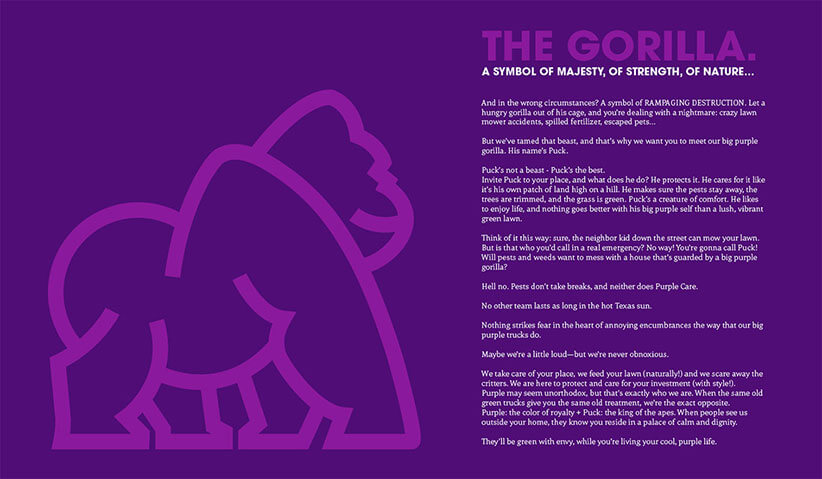What is Verbal Identity?
A Verbal Identity is the articulation of your brand through the use of distinct and focused language, entirely expressed through words. It’s not by accident that some employers call their employees members or partners. The words a business uses can be tailored to specific syllables, and every detail results in a range of variances. Businesses have to express their identity through their workers and consumers. This calls for customs, style, and verbal etiquette (otherwise known as “tone of voice”).
Similarly, as you would create a brand profile, Verbal Identity is pre-structured through usable phrases, ideas, and tones. Capturing these variances results in a brand that’s completely uniformed. Even more, conveying a brand’s identity through words is how you leverage the medium your leads use the most.
Verbal Identity makes you stand out and get noticed.
While this may seem fairly obvious on paper, defining and determining your brand’s Verbal Identity is one of the most critical aspects of your Brand Platform. In addition, by developing your voice ensures that you have the right words for, response to, and knowledgeable foresight into your brand’s challenges. By establishing Verbal Identity right now, you procure a marketing recipe that accounts for the doubts your consumer has. You can then build their confidence in you – whether through professionalism or friendliness.
Why You Need a Verbal Identity.
Suppose you’re already investing time, money, and resources into defining your Brand’s Strategy and Visual Identity. In that case, it’s imperative that you articulate in words the structures of your brand that work in harmony with everything else you have created.
A great Verbal Identity amplifies your brand.
A poor Verbal Identity can create confusion and may conflict with all of your hard work, reducing the quality of your marketing and messaging tactics. Customers need firm direction to follow, and a brand constantly changing their ethos and voice suggests they don’t really know what they are doing, a downfall for any growing business. Thus you need to put the work in and get your Verbal Identity right the first time.
How is Verbal Identity Used?
There are many ways a brand can utilize its strong voice. Whether in direct communications with their customers or through consistent copy across their website and social media pages, a uniform identity means this: you will have consistency and clarity in your brand for all outbound marketing and corporate endeavors. Similarly, it also:
- Infuses your brand’s personality in messaging, including voice, attitude, sense of humor, and more into your actual content and copy.
- Aims to distinguish your brand from competitors.
- Creates a consistent personality and voice of the brand across all communication channels.
Whether you use a copywriter or produce your own marketing, a Verbal Identity gives a creator the tools they need to ensure every brand touchpoint is accurate to your character.
What are the components of a Verbal Identity?
A Verbal Identity is broken down into five parts. Let’s delve into each one.
- Brand Voice: Here, we determine how you should sound and also, more importantly, how others hear you. Just think of the difference you experience watching loud versus persuasive speakers.
- Brand Story: The content you’ll develop in the future should be based on your story – which is a verbal articulation of what your brand ultimately stands for.
- Brand Tone: Through tone, we can all hear the frustration versus delight people have, even if two people use the same words. Mastering your tone enables you to build trust and integrity.
- Brand Grammar: Some brands excel the more they disrupt grammar, using it for their own way of speaking. Perfecting this, however, calls for practice, science, and some research.
- “What we say. What we don’t say.”: You’ll soon reach a point of always knowing what to say. This starts with first establishing what not to, as in to never, express publicly. This could be something as simple as choosing to never promote yourself by insulting the competition or as major as keeping controversial political opinions to yourself (if they aren’t beneficial to your business and relatable to your customers).
01. Brand Voice
Your Brand Voice is your brand’s personality, come to life. It is the way your brand communicates directly in its content, copy, and overall language. It’s not just about what you’re saying, but the manner in which it is being said. It’s the unique turn of phrases and attitudes you showcase when communicating.
Example: Changing Habits
Changing Habits, an Australian-based whole food company, is influencing how food is produced, classified, and marketed.
Our team helped them create a Brand Strategy that would require a distinct new Brand Voice: authentic, real, direct, aspirational, curious, and inclusive. Below are some explanations of their new Brand Voice:
- “We strive to uplift everyone around but refuse to make false promises and tell people what they want to hear. While sometimes uncomfortable in the short run, in the long run, it creates trust and authority.”
- “We speak plainly in language that anyone can understand and avoid marketing buzzwords that create the potential for misinterpretation.”
- “We believe in the power of positivity. We don’t see problems, we see challenges and opportunities. We don’t make demands but encourage instead. And while we take ourselves seriously, we are also unafraid to throw in a little snark and playfulness when appropriate.”
02. Brand Story
A Brand Story is an emotional articulation of what your brand and company ultimately stand for. It is meant to tell both the story of your business as well as the audience you are trying to reach. It showcases not only the philosophy of your business but also the voice and personality of your brand.
Example: Purple Care
Purple Care is the premier lawn, tree, and landscaping company proudly (and locally) owned and operated in the greater Fort Worth, TX area. They are a huge, active part of their local community and are keeping it beautiful by taking a holistic, sustainable approach to lawn care.
When we rebranded their company from Xtreme Lawncare to Purple Care earlier this year, we felt it was necessary to write a story that would bring to life this new name and the introduction of a gorilla in their logo.
Here is their Brand Story:
03. Brand Tone
A Brand Tone reflects your brand’s stance, attitude, and disposition in a given situation. What distinguishes Brand Tone from Brand Voice is the ability for adaptation. Your Brand Voice will always be the same; your Brand Tone will be consistent but situation-dependent.
One of the best ways to determine the tone of your brand in the context of the communication. How do you speak to a friend? Do you speak differently in the confines of a private conversation vs. one on social media? Are there times where your tone is more formal or more casual?
Mastering your tone is all about understanding situations and communicating appropriately without negotiating on your core voice.
Example: Hunter + Esquire
Hunter + Esquire specializes in helping cannabis companies elevate their business, brand image, and company culture by helping them win and retain professional and qualified executives.
Hunter + Esquire’s tone is assertive, animated, and informative. As such, they make bold statements:
- We believe in possibility.
- We want to inspire our audience.
- We use active voice.
04. Brand Grammar
Your Brand’s Grammar sets a standard for how you communicate. It establishes specific rules and guidelines for how your content and copy is created so that regardless of who is writing for you, there is consistency. Without set guidelines, it may often be confusing to the reader, which ultimately creates a disconnect.
Some elements to consider for your Brand’s Grammar:
Abbreviations & Acronyms
Do you write out unfamiliar abbreviations or acronyms on the first reference, and then use shortened versions
Capitalization
When do you capitalize? Are all email addresses and URLs in lowercase?
Contractions
Do you use contractions when speaking conversationally?
Emojis
Are they appropriate for your brand? If so, when and in what capacity?
Numbers
When do you spell out numbers and when do you write them out?
05. “What We Say. What We Don’t Say.”
Your Brand Voice is your brand’s personality, come to life. It is the way your brand communicates directly in its content, copy, and overall language. It’s not just about what you’re saying, but the manner in which it is being said. It’s the unique turn of phrases and attitudes you showcase when communicating.
Having clear-cut rules about how your brand speaks in regards to specific topics is crucial. Creating a “What we say and what we don’t say” list helps you frame conversations properly and avoid using terms not in alignment.
When crafting your list, think about:
- Are there words your brand should avoid using? (Can’t. Don’t. Shouldn’t.)
- Do you use specific terms to describe your customers, clients and, team members?
- How do you talk about your industry?
- How do you talk about the competition?
- How do you talk about your services? Do you have proprietary language about your process?
The list can get extensive, but the more you think this through and the better defined your list becomes, the more comprehensive brand language and vocabulary you can create.
Creating Your Brand’s Verbal Identity
As you can see, a lot goes into creating a powerful and distinguished Verbal Identity. We’ve just shown you the broad strokes — but when you’re ready, reach out to us to have us help you with your Verbal Identity.
We’re specialists in nailing branding according to what your audience needs and our processes will help you explore your tone of voice for consistent, effective marketing. In addition, we have a variety of branding resources you can use at no cost to you. From case studies to our branding courses, why not learn about the difference we can make for your company?
Instead of ignored emails and silent social media, make engaging impacts and statements with every new communication.








